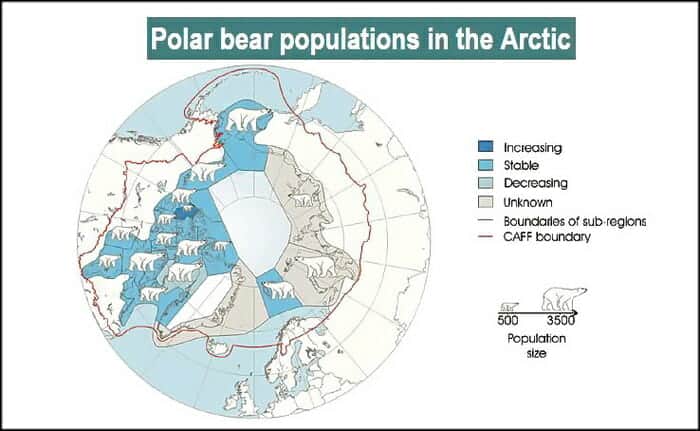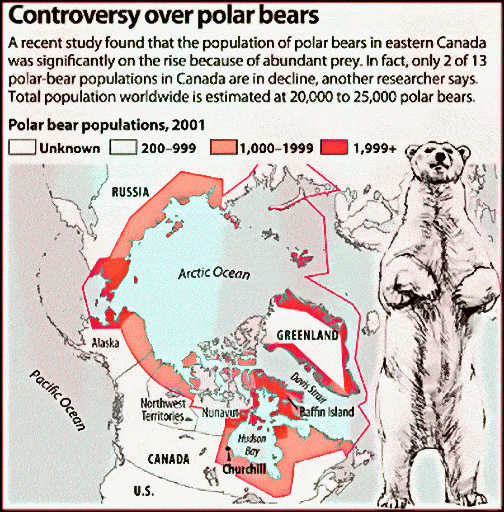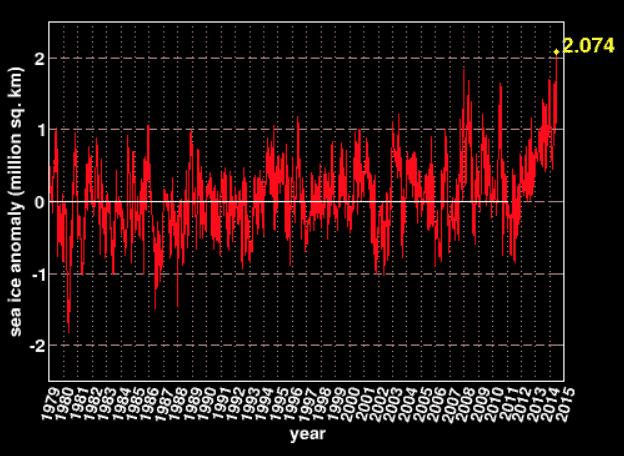(For an update on this topic, see this post)
From a FaceBook discussion… I incorporate Al Gore’s thinking:
Look, it is simple:
Either polar bears are dying because of CO2 emissions via man ~ hence, we should stop producing high levels of CO2;
or [following the train of thinking FROM Al Gore],
Polar bears are at their highest recorded population levels because of CO2 emissions via man, hence, we should produce high levels of CO2.
If “a,” why not “b”?

This is meant mainly as a supplement to a Christmas Eve-Eve gathering/discussion I was at. I will make this post a little different than other posts, as, it will be “minimalist.” This is the fourth installment of the topics covered, which are polar bears, rising sea levels, CO2, Inconvenient Truth (the movie), nuclear power, warmest year, electric vehicles (EVs)/hybrid cars, and bullet trains.
Read more. Here are some designations I will use in stories linked to:
Either the polar Bear population is at record levels/health, or they are not.
Either one is true and the other false. Both cannot be true. So where do we align our opinion with that reflects the evidence closest?
In other words… we are asking a question or drawing a distinction that is beyond opinion:
“…there are about 25,000 polar bears across Canada’s Arctic. ‘That’s likely the highest [population level] there has ever been’.”
(more below)
- Main-stream (MS) news sources such as the New York Times or CNN;
- As well as non-main-stream sources or “new media” (NMS), which include blogs by either specialists or new media news sources. These typically reference and link to main-stream news sources or “neutral” media [see below];
- I will also try to include more “neutral” media (NM), such as the World Wildlife Fund or NASA.
I do this in the hopes that those reading this from the conversation will have a better recourse — outside of myself — to complete a picture I was trying to (not too well considering the new wines and beer making their rounds for our tasting pleasure). I will first, however, deal with Polar Bears.
If someone were to happen across this post I would at least like them to think long and well on this one issue. And it is this: we may hold an opinion, yes… but we cannot “own” our own facts.
So… for instance. From the conversation polar bears were brought up as an evidence for man-caused global warming impacts. The “Inconvenient Truth” was mentioned as a source for this dilemma… and… I must say… this is a great commentary on the power of media. As we will see. I own and have watched the Inconvenient Truth. But I own and also have watched the Great Global Warming Swindle. This isn’t to “toot” my own horn but is how I challenge my children to think critically. Look at both sides and make a fully informed decision.
Which is much needed in our political and social discourse. For instance, Ronald Reagan and Tipp O’Neil were ideological foes, coming to conclusions on most things as opposites can allow. HOWEVER, Reagan and Tipp would regularly meet to talk, smoke cigars, and debate vigorously their ideas and would try and compromise. [Obama has met once with John Boehner, FYI]
In our current dialogue one side often finds solace in demonizing the other as anti-science, or sexist, intolerant, xenophobic, homophobic, Islamophobic, racist, bigoted.
- Who would have a serious discussion with someone who is a believer in a flat-earth (anti-science)?
- Who would want to talk about anything with someone who is a racist?
Which brings to a 21-second blurb by a very left-leaning professor saying that this type of thinking is damaging to the young liberal student:
To wit….
Either the polar Bear population is at record levels/health, or they are not.
Either one is true and the other false. Both cannot be true. So where do we align our opinion with that reflects the evidence closest? In other words… we are asking a question or drawing a distinction that is beyond opinion.
POLAR BEARS
Sources Of Myth
(MS) JUNEAU, Alaska (AP 7/2011) — Just five years ago, Charles Monnett was one of the scientists whose observation that several polar bears had drowned in the Arctic Ocean helped galvanize the global warming movement….
(MS) JUNEAU, Alaska (The Guardian via the AP, 12/2013) An Alaska scientist whose observations of drowned polar bears helped galvanize the global warming movement has retired as part of a settlement with a federal agency.
[….]
…In 2004, during an aerial survey of bowhead whales, Monnett and another researcher saw four dead polar bears floating in the water after a storm, observations that were later detailed in a peer-reviewed article. They said they were reporting to the best of their knowledge the first observations of the bears floating dead and presumed drowned while apparently swimming long distances.
They said their findings suggested drowning-related deaths of polar bears may increase in the future if the regression of pack ice or periods of longer open water continues. The observations helped make the polar bear a symbol for the climate change movement.
(NMS) American Thinker (5/2014, via Polar Bear Science) The greatest scientific fraud in history is slowly but surely unraveling, and the breadth of the corruption revealed is stunning. As any good con man knows, and emotional appeal is necessary, and the warmists found their cuddly-looking icon of endangerment in the polar bear, an animal frequently chosen as stuffed toys for children to hug. Pictures of polar bears on ice floes, presumably doomed to death by drowning as the Arctic ice disappeared, were used to tug on the heartstrings of adults and children alike, in order to scare them into willingly handing over power over their economic destiny to global mandarins who would reduce their standard of living.
But it was necessary to come up with “scientific” estimates of polar bear populations that showed them in danger. With all the billions of dollars available for global warming-related research, and the level of peer pressure that money generates, it wasn’t that difficult….
(NMS) Internation Climate Science Coalition (ICSC) September 7, 2012: “Polar Bear Propaganda – A Useful Tool for the Promotion of Environmental Hysteria and Politicized Science“, by Tim Ball, PhD, environmental consultant and former climatology professor, University of Winnipeg (founded the Rupertsland Research Centre). Now residing in Victoria, British Columbia, Canada. Published as a Frontier Centre for Public Policy (www.fcpp.org) Special Report.
“It was convenient with the new environmental paradigm and attribution of all change to humans to claim global warming causing melting [sea] ice was killing the polar bears. It was wrong and policy based on it is unnecessary and unjustified. The Inuit are victims of what Paul Driessen wrote about in his book EcoImperialism, the forceful imposition of western environmental values on other cultures, usually to their detriment.
“Nobel Physicist Richard Feynman said, “Reality must take precedence over public relations, for nature cannot be fooled.”
“Polar bears have successfully adapted to nature for eons before civilization began. That must be the basis for policy, not data severely limited and distorted by emotional, anthropomorphic, political agendas presented under the guise of the precautionary principle.”
Read whole paper.
Read introductory remarks by Peter Holle, founding President of the Winnipeg, Canada-based Frontier Centre for Public Policy.
Polar Bear Population
Most recent update ~ accessed 3-18-2015 ~ via the IUCN Species Survival Commission:
The PBSG first provided a global population range estimate for polar bears in 1993. The range specified at that time, 21,470-28,370 polar bears, included statistically solid estimates (e.g. based on studies to estimate population abundance) for many of the identified polar bear subpopulations, and estimates (based knowledge of habitat quality and input from scientists) for several other subpopulations. Recognizing the false precision implied by a range of 21,470-28,370, the estimate was rounded to 22,000-27,000 in 1997. After some new population estimates were developed and after more discussion of the possible numbers in areas without estimates, the range was adjusted to 21,500-25,000 in 2001, and further simplified to 20,000-25,000 in 2005. The variation in ranges reflects the absence of rigorous estimates of subpopulation size in several areas and the consensus desire to express a reasonable round number range that could not be interpreted as more reliable than it really is.
Over the years following the first global population range estimate, the PBSG has refined subpopulation size estimates in some areas, but there still are areas where we have only educated hypotheses regarding numbers of animals present. Currently, the PBSG recognizes 19 subpopulations in the circumpolar Arctic. Scientific estimates are available for 14 (Baffin Bay, Barents Sea, Davis Strait, Foxe Basin, Gulf of Boothia, Kane Basin, Lancaster Sound, M’Clintock Channel, Northern Beaufort Sea, Norwegian Bay, Southern Beaufort Sea, Southern Hudson Bay, Viscount Melville Sound, and Western Hudson Bay). Abundance in these 14 populations was estimated using accepted inventory methods (e.g., mark and recapture or aerial survey). These estimates, descriptions of how they were developed, and the history of how they have been improved over the years, can be viewed in the population status tables (to be viewed in the proceedings). Until 2005, the PBSG status table also included estimates for 3 subpopulations (Chukchi Sea, Kara Sea, and Laptev Sea) where accepted methods never had been applied. These estimates were removed because including them in the table suggested they were more reliable than they really were. The PBSG has never provided estimates for two other regions (Arctic Basin and East Greenland). Bear numbers in the Arctic Basin are very low and bears present there may simply be passing through rather than representing a true subpopulation. East Greenland appears to have a resident group of polar bears but the PBSG has never ventured an estimate of their abundance.
For the 14 subpopulations with scientific estimates, the sum of the mid-point estimates is 18,349 bears (see http://pbsg.npolar.no/en/status/status-table.html for estimates). The PBSG expects that the number of bears ranges from several hundreds to a few thousands in each of the subpopulations in Chukchi, Kara, Laptev and East Greenland, bringing the midpoint estimate to approximately 25,000.
Because the global population estimate range includes subpopulation estimates of variable quality it is not used as a monitoring benchmark or other status assessment tool. Rather, it simply expresses a reasonable range in numbers, based on a combination of the best available information and understandings of polar bear habitat. Conservation assessments focus on the trends in subpopulations for which statistical estimates are available. Some of those subpopulations are declining, others are stable, and some may be increasing.
(MS) WINNIPEG, Canada (Globe and Mail 4/2012) The number of bears along the western shore of Hudson Bay, believed to be among the most threatened bear subpopulations, stands at 1,013 and could be even higher, according to the results of an aerial survey released Wednesday by the Government of Nunavut. That’s 66 per cent higher than estimates by other researchers who forecasted the numbers would fall to as low as 610 because of warming temperatures that melt ice faster and ruin bears’ ability to hunt. The Hudson Bay region, which straddles Nunavut and Manitoba, is critical because it’s considered a bellwether for how polar bears are doing elsewhere in the Arctic.
[….]
But many Inuit communities said the researchers were wrong. They said the bear population was increasing and they cited reports from hunters who kept seeing more bears. Mr. Gissing said that encouraged the government to conduct the recent study, which involved 8,000 kilometres of aerial surveying last August along the coast and offshore islands.
Mr. Gissing said he hopes the results lead to more research and a better understanding of polar bears. He said the media in southern Canada has led people to believe polar bears are endangered. “They are not.” He added that there are about 25,000 polar bears across Canada’s Arctic. “That’s likely the highest [population level]there has ever been.”
[Editors note: perhaps to 27,000-32,000?]
(NMS) Gateway Pundit (7/2011) of the same, but updated info of populations:
(NM) “The total number of polar bears worldwide is estimated to be 20,000-25,000.” [pg. 33]
[….]
“The world’s polar bears are distributed in 19 subpopulations over vast and sometimes relatively inaccessible areas of the Arctic. Thus, while the status of some subpopulations in Canada and the Barents Sea is well documented, that of several others remains less known [sic]. Thus, it is not possible to give an accurate estimate of the total number of polar bears in the world, although the range is thought to be 20-25,000.” [pg. 61, press release]
Aars, J., Lunn, N. J. and Derocher, A.E. (eds.) 2006. Polar Bears: Proceedings of the 14th Working Meeting of the IUCN/SSC Polar Bear Specialist Group, 20-24 June 2005, Seattle, Washington, USA. Occasional Paper of the IUCN Species Survival Commission 32. IUCN, Gland (Switzerland) and Cambridge (UK). http://pbsg.npolar.no/en/meetings/
(NM) “The total number of polar bears worldwide is estimated to be 20,000-25,000.” [pg. 31]
[….]
“The total number of polar bears is still thought to be between 20,000 and 25,000. However, the mixed quality of information on the different subpopulations means there is much room for error in establishing that range. That potential for error is cause for concern, given the ongoing and projected changes in habitat and other potential stressors.” [pg. 86, press release]
Obbard, M.E., Theimann, G.W., Peacock, E. and DeBryn, T.D. (eds.) 2010. Polar Bears: Proceedings of the 15th meeting of the Polar Bear Specialists Group IUCN/SSC, 29 June-3 July, 2009, Copenhagen, Denmark. Gland, Switzerland and Cambridge UK, IUCN. http://pbsg.npolar.no/en/meetings/
Recent Population Increase Partly Due To Lots of Sea-Ice
(MS) Canada (CBC News via the Canadian Coast Guard, 3/2014) [ARCTIC Sea Ice] The Canadian Coast Guard is pleading with merchant ships to plan their voyages well in advance this year as the organization’s icebreaker fleet confronts some of the worst ice conditions on the Atlantic Ocean in decades.
“Plan your voyage and we’ll all get through this,” said Mike Voight, the Atlantic region’s director of programs. “We’ve got a pretty bad or challenging ice year.”
The Canadian Ice Service, an arm of Environment Canada, said there is 10 per cent more ice this year compared to the 30-year average.
“We probably haven’t seen a winter this bad as far as ice for the past 25 years,” said Voight, referring to both the amount and thickness of the ice….
(NM) The American Geophysical Union (AGU) Abstract (12/2014) [ARCTIC sea ice] Despite a well-documented ~40% decline in summer Arctic sea ice extent since the late 1970’s, it has been difficult to estimate trends in sea ice volume because thickness observations have been spatially incomplete and temporally sporadic. While numerical models suggest that the decline in extent has been accompanied by a reduction in volume, there is considerable disagreement over the rate at which this has occurred. We present the first complete assessment of trends in northern hemisphere sea ice thickness and volume using 4 years of measurements from CryoSat-2. Between autumn 2010 and spring 2013, there was a 14% and 5% reduction in autumn and spring Arctic sea ice volume, respectively, in keeping with the long-term decline in extent. However, since then there has been a marked 41% and 9% recovery in autumn and spring sea ice volume, respectively, more than offsetting losses of the previous three years. The recovery was driven by the retention of thick ice around north Greenland and Canada during summer 2013 which, in turn, was associated with a 6% drop in the number of days on which melting occurred – climatic conditions more typical of the early 1990’s. Such a sharp increase in volume after just one cool summer indicates that the Arctic sea ice pack may be more resilient than has been previously considered.
(NMS) Talking About Weather (7/2014) [ANTARCTIC sea ice] Antarctic sea ice has hit its second all-time record maximum this week. The new record is 2.112 million square kilometers above normal. Until the weekend just past, the previous record had been 1.840 million square kilometers above normal, a mark hit on December 20, 2007, as I reported here, and also covered in my book.
Mark Serreze, director of the National Snow and Ice Data Center, responded to e-mail questions and also spoke by telephone about the new record sea ice growth in the Southern Hemisphere, indicating that, somewhat counter-intuitively, the sea ice growth was specifically due to global warming.


